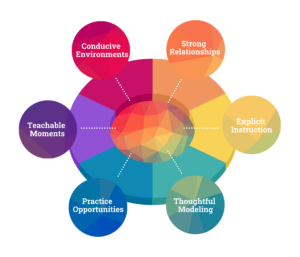During the COVID-19 pandemic, many district leaders are grappling with the new challenges of social emotional learning, among other things, in a virtual learning environment. Particularly when teachers, administrators, and counselors are not accustomed to remote learning, several questions emerge on exactly how to continue cultivating relationships and environments that support social-emotional skills and mindsets.
 Many districts and schools are utilizing the SEL Integration Approach we created last year. Though all of its main components–conducive environments, strong relationships, explicit instruction, teachable moments, practice opportunities, and thoughtful modeling–are research-based pedagogical components we intended primarily for classrooms, many strategies can be applied to the world of virtual learning. Two important components during this transition from schools to home are building strong relationships with students, families, and staff, and fostering a supportive, conducive environment for learning. So how do related classroom strategies apply to virtual learning?
Many districts and schools are utilizing the SEL Integration Approach we created last year. Though all of its main components–conducive environments, strong relationships, explicit instruction, teachable moments, practice opportunities, and thoughtful modeling–are research-based pedagogical components we intended primarily for classrooms, many strategies can be applied to the world of virtual learning. Two important components during this transition from schools to home are building strong relationships with students, families, and staff, and fostering a supportive, conducive environment for learning. So how do related classroom strategies apply to virtual learning?
Creating and maintaining predictability for students outside the classroom is critical (perhaps more so than inside the classroom!). While potentially more difficult to implement virtually, strategies and routines such as Advisory, Morning Meeting, and Crew can be effective in establishing consistency. Suggesting specific schedules or creating a class or family charter can establish norms for a safe and supportive virtual environment. Additionally, educators might also consider the challenges students face in their physical environment, such as finding a dedicated area that is quiet and safe. The family charter can be used to address these needs, as well as resources such as this helpful article on creating a “home office” for students.
Teachers and administrators can monitor sense of connection by highlighting students who are particularly vulnerable or isolated using strategies suitable for a virtual environment, such as relationship mapping and quick planned check-ins. Educators can also leverage technology to maintain connection and communications through ‘show & tell’ or simple sharing activities with Padlet or Flipgrid.
Lastly, since many students are working from home with their families nearby (and sometimes directly involved in their learning), promote positive family connections through assignments like the Family Interview or an oral history project where students can more deeply explore their personal and family background, values, and culture.
Teaching, leading, and learning in the new context of a pandemic invites several new challenges for students and adults; however, continuing to prioritize relationships and supportive environments will help alleviate the stress, anxiety, and disorganization that accompanies this uncertain transition. While this list of resources is far from complete, we feel that they offer actionable strategies that can be readily applied in a virtual environment. Keep an eye out for our next blog post, where we’ll explore two more components of the SEL Integration Approach: Explicit Instruction and Thoughtful Modeling.


